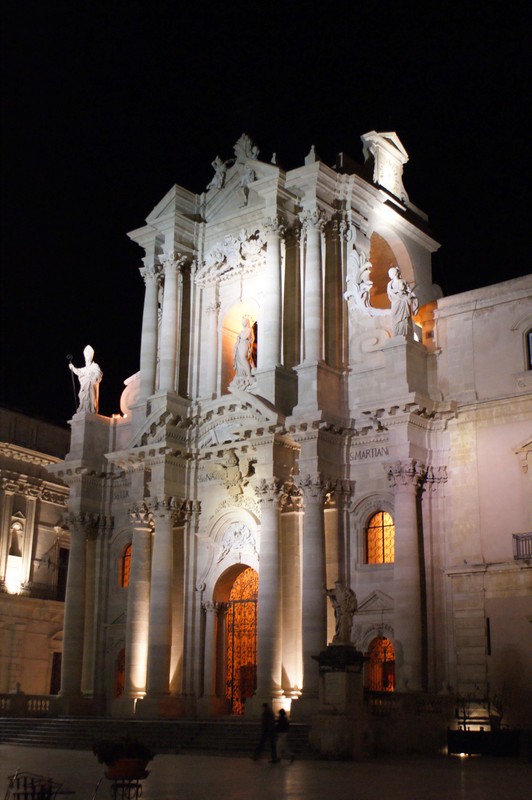Piazza Duomo in Syracuse is strongly suggestive, and is considered among the most beautiful squares in Italy. It has a semi-elliptical shape and is dominated by the imposing facades of beautiful palaces, of the Baroque Cathedral (Duomo) and of the Church of Saint Lucia alla Badia. The magnificient cathedral, recently restored, is integrated into the ancient structure of the temple of Athena of the fourth century A.C., whose doric columns are still visible inside the church and along the external walls.
The doric temple of Athena was built in the fifth century BC the tyrant Gelon, after the victory against the Carthaginians in the battle of Himera. The so called “Athenaion” was hexastyle (six columns in front) peripteral (columns cell surrounded on all four sides), with 14 columns on the long sides. The pediment bore the great shield of the goddess in a gilded bronze.
Currently some columns and parts of the stylobate, made of local limestone, are visible on the left side of the cathedral, while other parts (marble tiles and gutters in the shape of lion's head) have been moved to the Regional Archaeological Museum Paolo Orsi. Inside the Duomo are also clearly visible 9 columns on the right side and the two in front of the cell. According to the results of some excavations made during the first years of the twentieth century, before the building of the temple in that area there was another sacred place of worship dating back to the seventh century BC. This area therefore has been sacred for nearly 3000 years and still is.
In the seventh century. A.D., byzantine period, the temple was transformed into a Church by the Bishop Zosimus. The church was dedicated to the Nativity of Mary and the colonnade of the temple was encompassed in the outside walls, while in the inner walls of the old cell there were 8 open arches on each side, in order to achieve the result of a building with three naves, each ending with an apse. Also the walls that divided the space in the back ("opisthodomos") from the cell and from this porch were eliminated.
The orientation of the building was also reversed and the current facade of the Duomo is located in the back of the temple. In Norman times the walls of the nave were built and the windows were opened, while the apse was decorated with mosaics. The polychrome floor dates from the fifteenth century and in 1518 the nave was covered with the wooden ceiling, still preserved. In the sixteenth century the tower was also erected. After the 1693 earthquake that severely damaged the structure, the apses were removed and the chancel was occupied by a large Baroque altar made by Giovanni Vermexio, which reused a block of the architrave of the ancient temple to make the altar table. The reconstruction of the damaged facade was made in Baroque style by Andrea Palma and ended in 1753. In 1757 the statues of the "Virgin of Piliere", of "Saint Lucy" and "San Marciano" were added, all made by Ignazio Marabitti, to whom we owe also the statues of "San Peter" and "St. Paul" on the sides of the entrance steps.
In the south aisle several chapels are located: the chapel of the Baptistery, with the with the Hellenistic (or according to others Norman) baptismal font, the chapel of Saint Lucia with the silver statue of the Patron Saint, locked in a niche open for regular exposure to citizenship during Saint Lucy's festival on December 13th. The chapel of the Sacrament, with polygonal frescoes of the seventeenth century and with the “ciborium“ by Luigi Vanvitelli of 1752, the chapel of the Crucifix, built at the end of the seventeenth century to replace the lower southern apse, which houses a painting of "St. Zosimus" commonly attributed to Antonello da Messina.
In Piazza Duomo is also located Palazzo Vermexio (the name comes from Giovanni Vermexio, the architect who designed it and built it in 1629), also known as the "Palace of the Senate", the town hall of the city of Syracuse. It was built on the ruins of the first and unfinished Ionic temple next to Palazzo Salonia-Interlandi and opposite Palazzo Beneventano del Bosco, which was built just after the earthquake of 1693. The junction between the square and Via Picherali, is overlooked by the beautiful Palazzo Borgia del Casale
DUOMO.
Timetables:
Everyday from 7.30 to 19.30
Free entrance.

